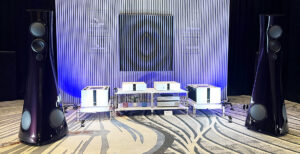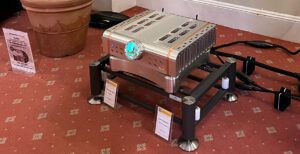
Britannia Row Productions started life in 1975 as a permanent base for Pink Floyd’s tour PA and technical crew. It quickly became a business in its own right, hiring out lights, sound, staging, and crew to other artists, eventually breaking out on its own in 1984, with a management buy-out. Although, the Floyd would remain one of Britannia Row’s principle tour clients, by that time, the company was providing live music support for an ever-increasing and diverse portfolio of artists, including everyone from Frank Sinatra to Dire Straits. The company now provides tour live sound for bands like Kasaban, Rudimental, Robbie Williams, and the Foo Fighters, but also works with even larger venues, and was pivotal in providing the live sound for Live8, Live Earth, and the opening and closing ceremonies for the London 2012 Olympic Games and Paralympics.
%20Farrell%20Music%20Ltd.jpg.jpg)
Live sound has seen something of a flourishing of late, and certainly as the demand for experienced recording professionals diminishes, the demand for live sound expertise is increasing steadily. However, the industry is facing a problem of demographics; the first generation of technical crew, who founded a live sound industry out of the limited products available in the 1960s and 1970s are all reaching retirement age, and newcomers to ‘pro sound’ still view the studio system as a viable career path.
Which inexorably leads to Britannia Row Productions Training.
Facing an impending skills-set crisis, Britannia Row sought to provide full practical training for the next generation of live sound experts. This is different to the academic training that’s also available, as it’s very hands-on; the 18 students on the intensive 12 week course develop the core skills needed to become a competent technician, one who can construct, operate, and help maintain all the complex requirements of a live sound rig. Given that this kind of technology in place could cost as much as $2.5m, it’s important that technicians working in this environment know what they are doing; not only is the sound of the live event in their hands, but mistakes can be very costly.
The finer points of microphone technique and mixing cannot be taught in such an intensive environment, but the course is considered a jumping-off point, and course graduates would be expected to be able to create a well-set-up live sound system and perform a technically proficient, but not necessarily actively creative, mix.
A $10,000 course designed ideally for keen twentysomethings with some live sound experience looking to build on their skills is interesting, but not core to the domestic high-end audio world. But our visit also included a lengthy compare-and-contrast session with the course director, Barry Bartlett. Interestingly, what it shows in many respects is not only how far both live and domestic audio have come, but how far domestic audio has to catch up.

It’s easy to dismiss live audio with visions of large, leather-clad ‘Road Managers’, manhandling large black bass bins out of the back of a small truck, but the reality for the larger tours is a team of computer-literate technicians pawing over data-filled screens. At the higher-levels of live sound, analogue ends with the microphone preamps, and is otherwise there as back-up. Everything else is in the digital domain, right down to the DSP-derived loudspeaker crossovers in the active line array monitors. Links between the back-line Direct Injection and micreophone preamp units, the on-stage monitoring desk, and the front-of-house mixing desk are all AES 50 networked connections with large copper analogue wire now reserved for emergency use. Spectrum analysis and measurement of the venue (along with pre-tour planning) largely dictate the size and shape of the PA itself (although the band can go all Iron Maiden and demand ever larger systems), and similar programs dictate both placement and active equalisation required to get the best possible sound to the most possible people in the room.
While these requirements are different to our own, we can see some aspects of professional sound creeping into the home at last. Increasingly, we are seeing systems that deliver audio across Ethernet lines, with provision for a networked server and storage held in a ‘plant room’ away from the main listening room. DSP has not proven as popular, but brands like Devialet, Linn, Lyngdorf, Meridian, TacT, and Trinnov all use some form of DSP-based room or loudspeaker correction, while Linn, Lyngdorf, and Meridian take this a stage further to include active amplification. Given the rate of change to the live sound people (this was something new in the mid 1990s but 20 years later, the idea of not using DSP is almost alien to the professionals in the field), it’s possible we will see this being implemented in more and more places in audio.
The big difference intellectually is live sound doesn’t have the luxury of making an ideal sound for one person, and has to provide a good sound around the venue, even if the ‘hot seat’ effect suffers. This, and the need for a lot of amplification and loudspeakers that can project sound into a large auditorium, means high-power Class D amplifiers. This is not being followed in the specialist audio world, in part because we don’t have the same weight and heat constraints as befall the pros in this field. But also the power requirements are reduced; we don’t need a loudspeaker capable of being driven by several kilowatts in order to fill a venue. This possibly makes the reason for passive loudspeakers more understandable in the home; the ‘power sink’ those passive components produce is not a problem given the constraints of the domestic space, but represents a call for hundreds of watts more power in the live space in order to replicate the performance of the active system.
What you should take from this is this; if you, or someone you know, are considering a career in the music business, the live event isn’t just the preserve of The Neanderthal Roadie Club anymore. It’s a legitimate career path, with complex technical demands every bit as sophisticated as any Cisco network professional might encounter. If you think pro audio is the idiot brother of domestic audio, think again; that installation in your concert hall or place of worship is possibly a lot more nuanced and technologically-oriented than your equipment in the home, and if you are wondering what the future of audio in the home might look like in a dozen years time, go to a concert, and look what’s going on at the back of the room.
Tags: FEATURED
By Alan Sircom
More articles from this authorRead Next From Blog
See all
AXPONA 2024 Show Report Part One
- Apr 19, 2024

Audio Show Deluxe 2024: A photo show report
- Mar 28, 2024

Paul Messenger 1949-2024: A personal tribute
- Mar 26, 2024

Bristol Hi-Fi Show 2024: See You There!
- Feb 21, 2024













